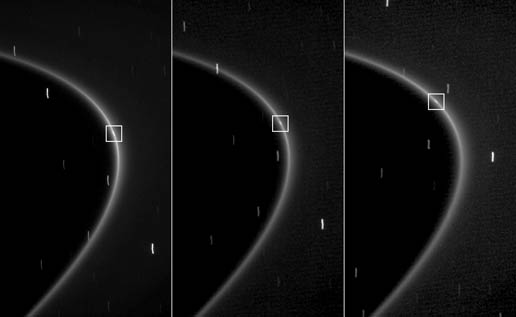The Cassini spacecraft discovered a small moon embedded within the G ring. This moon looks like a pale point of light. The scientists believe that this moon is the source of the material in the G ring

The Cassini spacecraft discovered a small moon embedded within the G ring. This moon looks like a pale point of light. The scientists believe that this moon is the source of the material in the G ring.
The scientists analyzing the images from Cassini, which were taken over the course of about 600 days, discovered a tiny moon, about half a kilometer in diameter, integrated into a partial ring, or arc, which was discovered even before the moon, and was called the G ring. The researchers announced the findings on the mailing list of the International Astronomical Society.
Before Cassini, the G ring was just a ring of dust that could not be associated with any known moon, which made it strange and unusual among rings." says Matthew Hedman, a Cassini team member from Cornell University in Ithaca, New York. "The discovery of this moon, together with other data from Cassini, should help us make sense of Cassini's previous discovery of the mysterious ring.
Saturn's rings are named according to the order of their discovery, and if you arrange them from the closest to Saturn to the farthest, then the closest is D followed by C, the farthest from it is B, followed by A, and then F. The G ring is next in line and the farthest known today is the E ring. The G ring is therefore one of the pale outer rings. Inside the G ring is a 250-kilometer-wide arc containing material, and it stretches for a distance of 150 kilometers, or about one-sixth the circumference of Saturn at its altitude. The moon moves within the arc. Previous measurements of the plasma and dust made by Cassini testified to the existence of this partial ring and believed that it could have been formed from materials scattered by a moon making its way inside the ring.
The scientists observed the tiny moon on August 15, 2008, and confirmed its presence in two previous images. Since then it has been seen many times, and was most recently observed by Cassini on February 20. The moon is immediately too small to be photographed clearly by the Cassini cameras, so its size cannot be measured directly, but the Cassini scientists estimate the diameter of the moon by comparing its brightness with another small moon of Saturn - Phalen. Hedman and his colleagues also discovered that the moon's orbit is disturbed by the neighboring large moon Mimas, which is responsible for keeping the ring trapped in its shape.
This discovery tops the number of small ringed moons that Cassini discovered by three. This moon may not be the only one in the G ring arc. Previous measurements by other Cassini instruments have detected the presence of a population of particles, 1-100 meters in diameter. "These meteorites are constantly colliding with each other and they can scatter dust inside the ring," Hedman said.
The connection between the new moon and Mimas shows the close link between the moons and the rings we see throughout the Saturn system, said Carl Murray of Queen Mary University of London. "I hope that in the future we can learn more about how such rings are formed and what their connections are with the parent bodies."
Early next year, Cassini will be at a convenient angle to view the new moon with its cameras. Her extended mission is scheduled to continue until fall 2010.

6 תגובות
Why don't Yotam turn to him? He has a website EURA.ORG.IL and I'm sure he will answer you
probably not.
Only, I can't forget... the day Hanan Sabat appeared on the children's channel and explained to the children about the different UFOs and the different extraterrestrials. explained some 'types' of extraterrestrials; "Reptilians" (or something like that. From the word 'reptiles') and others.
Illustrations were shown that looked like a Hollywood suit by an unimaginative designer.
Hanan also explained about their aircraft, which fly using some kind of anti-gravity. That is, they eliminate the influence of the huge masses in the area. appear to be.
It is not clear how Hanan knows all this.
Tell me people, what are you doing awake at two in the morning reading these articles?
go to sleep.
And regardless, a half-mile moon? Is it considered a moon at all? Isn't it too small?
Who will hear, "An unknown moon…." There is another block of rock that revolves around Saturn...
Very interesting article!